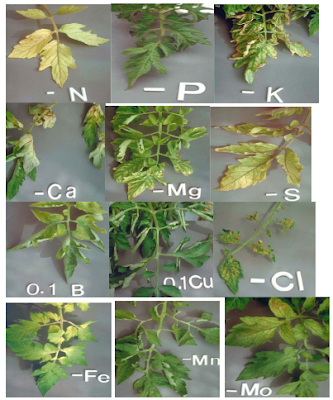 |
| Nutrient Deficiency symptoms in plants |
Nutrient Deficiency symptoms in plants
Nitrogen
General chlorosis (appearance of light-green to pale-yellow colour starting from the older leaves).The tips are first affected. Older leaves scorch or drop depending on the degree of deficiency. Growth becomes stunted and plant may have etiolated appearance. In acute case, flowering is greatly reduced. Deficient crops have lower protein content
Phosphorus
The mature leaves have characteristic dark-green to blue-green coloration. The root development is restricted, plant is spindly and stunted. In acute case, red, purple or brown leaf coloration develops and maturity is delayed. There is poor development of seed and fruit
Potassium
Slow and stunted growth of plants. Chlorosis along the leaf margins followed by scorching and browning of tips of older leaves. These symptoms gradually progress inward. Stalks are weak and plants lodge easily. Terminal and lateral buds may die (“dieback”). Shriveled seeds of fruits
Calcium
These are first noticed in the meristematic regions and the young leaves. The young leaves of new plants are often distorted, small and abnormal. Leaves may be cup-shaped and crinkled and the terminal buds deteriorate with some breakdown of petioles. Root growth is severely impaired. Roots get rotten. Buds and blossoms shed prematurely. Stem structure weakened
Magnesium
Inter-venal or marginal chlorosis, mainly of older leaves often accompanied by development of a variety of pigments. Chlorosis may also begin in patches or pouches which later merge and spread to the leaf margins and tips. With acute deficiency, the affected tissue may dry up and die. Leaves are usually small, brittle in final stages and curve upwards at margin. Twigs weak and prone to fungus attack, usually premature leaf drop
Sulfur
Younger leaves turn uniformly yellowish or chlorotic. Plants are spindly and grow poorly. Flower production is often indeterminate. Stems are stiff, woody and small in diameter
Zinc
Deficiency symptoms mostly appear on the 2nd or 3rd fully mature leaves from the top of plants. In some species, leaves may be dark-green or blue-green. Flowering and fruiting are much reduced under conditions of severe zinc deficiency, and the entire plant may be stunted and misshapen.
Boron
Growing tips are often damaged and may die. The leaves may become distorted, curling and becoming brittle. Stems become rough and cracked; often with corky ridges of spots. Flowers do not form. Roots are stunted and prone to bacterial infection. Brown heart in root crops characterized by dark spots on thickest part of the root or splitting at center. Fruits such as apples develop” internal and external cork” symptoms
Copper
Leaves may become chlorotic (yellowing) or deep blue-green. Curling of leave blades or rolling up of margins. Flowering and fruiting are curtailed. Ear production in cereals restricted and grains poorly set. Young shoots often die back, whereupon new shoots emerge from multiple buds further back, making for a bushy appearance. Annual plants may fail to develop and may die at the seedling stage.
Useful Agricultural Websites